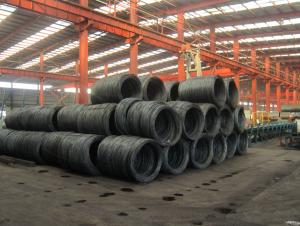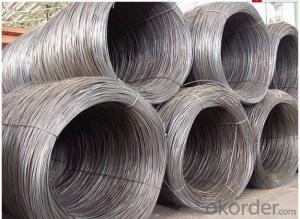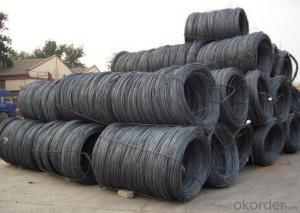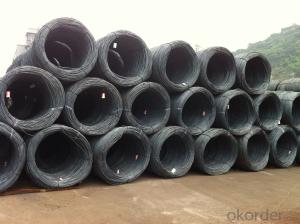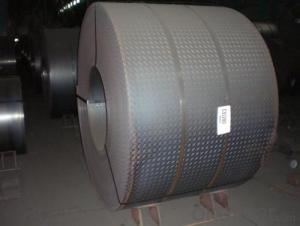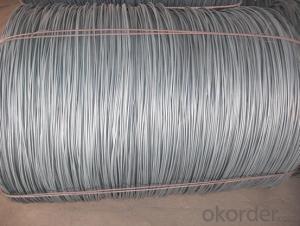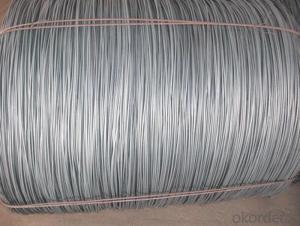GB Standard-Q195Steel Wire Rod with High Quality
- Loading Port:
- China Main Port
- Payment Terms:
- TT or LC
- Min Order Qty:
- 40 m.t
- Supply Capability:
- 15000 m.t/month
OKorder Service Pledge
OKorder Financial Service
You Might Also Like
Product Description:
Specifications of GB Standard-Q195Steel Wire Rod with High Quality:
Steel Grade: Q195 Standard:GB
Diameter: 6.5mm
6.5mm can be drawing into 2mm/8.0mm can be drawing into 3mm
Each coil weight about 2MT
Chemical Composition:
Please kindly find our chemistry of our material based on Q195 as below for your information
Trademark | Rank | Chemical composition (quality score) % | |||||
C | Si | Mn | S | P | |||
| ≤ |
| ≤ | ≤ | |||
Q195 |
| 0.06-0.12 | 0.30 | 0.25 | 0.050 | 0.045 | |
Trademark | Rank | Pulling Test | |||||
Bend PointΔs/Mpa | Tensile Strength | Elongation Ratioδ5% | |||||
Thickness (Diameter) /MM | Thickness (Diameter) /MM | ||||||
≤16 | 16-40 | ≤16 | 16-40 | ||||
≥ | ≥ | ||||||
Q195 |
| 195 | 185 | 315-390 | 33 | 32 | |
Usage and Applications of GB Standard-Q195Steel Wire Rod with High Quality:
After hot-rolled the products shaped into coil and delivery as finished product, including round, square, rectangular, hexagonal and so on. Since most of the products are round, it is generally called wire rod. Carbon steel wire rod is widely used in construction and manufacturing. Carbon steel wire rod is mainly used for reinforcement of reinforced concrete and welded structure or reprocessed (roberts , nail, etc.) materials, especially used to produce wire drawing, welding electrode, nails, spring, electronic, precise machinery parts and so on.
Production Process of GB Standard-Q195Steel Wire Rod with High Quality:
Steel billet---Heating---Rolling---Water-cooling---Coiling---Cooling---Inspection---Bundling---Exworks
Packaging & Delivery of GB Standard-Q195Steel Wire Rod with High Quality:
Packaging Detail: products are packed in coil and then shipped by container or bulk vessel
Each coil weight: About 2MT
Delivery Detail: within 45 days after received deposit or LC.
Label: to be specified by customer, generally, each bundle has 1-2 labels
Trade terms: FOB, CFR, CIF
FAQ:
Q1: How soon can we receive the product after purchasement?
A1: Within three days of placing an order, we will begin production. The specific shipping date is dependent upon international and government factors, but is typically one month.
Q2: How do you guarantee the quality of our products?
A2: We have established an advanced quality management system which conducts strict quality tests at every step, from raw materials to the final product. At the same time, we provide extensive follow-up service assurances as required.
Q3: The prices are invoicing on theoritical weight or on actual weight?
A3: We can do it in both manners, according to the customers' request.
Images of GB Standard-Q195Steel Wire Rod with High Quality:
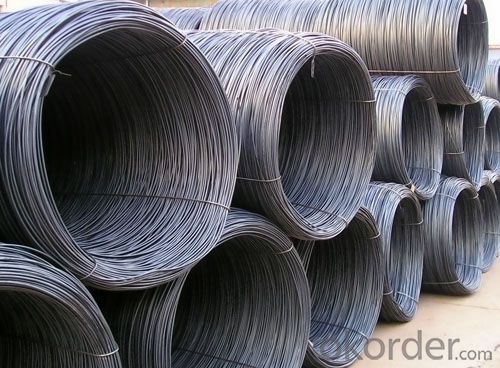

*If you would like to get our price, please kindly inform us the size, standard/material and quantity. Thank you very much for your attention.
- Q:What are the different machinability testing methods for steel wire rod?
- Steel wire rods have several available methods for testing their machinability, including: 1. The turning test involves using a lathe or turning machine to machine the steel wire rod. The cutting speed, feed rate, and depth of cut are adjusted to evaluate the material's machinability. The machinability characteristics are assessed by observing and analyzing tool wear, surface finish, and chip formation. 2. The drilling test uses a drilling machine to create holes in the steel wire rod. The cutting speed, feed rate, and drill geometry are modified to determine the machinability. The performance of the material during drilling is evaluated by examining hole quality, chip formation, and tool wear. 3. Tapping is a common machining operation performed on steel wire rods to create threaded holes. The tapping test involves tapping the steel wire rod using a tapping tool. The machinability of the material is determined by assessing the torque required, tool life, and thread quality. 4. Grinding is a precision machining process used to remove material from the steel wire rod. The grinding test includes grinding the steel wire rod using a grinding wheel or abrasive belt. The machinability is evaluated by adjusting the grinding speed, feed rate, and grinding wheel specification. The performance of the material during grinding is analyzed by examining surface roughness, material removal rate, and grinding wheel wear. 5. The hardness test indirectly assesses machinability by measuring the hardness of the steel wire rod. Hardness is an important mechanical property that affects machinability. Various hardness testing methods, such as Rockwell, Brinell, or Vickers hardness tests, can be performed to determine the hardness of the steel wire rod. Higher hardness values indicate lower machinability, while lower hardness values suggest better machinability. These testing methods assist manufacturers and engineers in selecting the most appropriate machining parameters and tools for processing steel wire rods. By understanding the machinability characteristics, they can optimize machining operations, improve productivity, and minimize tool wear and material waste.
- Q:What is the standard size range for steel wire rod?
- The specific application and industry requirements dictate the typical size range for steel wire rod. Generally, steel wire rod is available in diameters ranging from 5.5 millimeters (mm) to 25 mm. These sizes are commonly utilized in the construction, automotive, manufacturing, and electrical industries. It is crucial to consider that the size ranges of different steel wire rod grades are determined by their intended use and mechanical properties.
- Q:How is steel wire rod used in the telecommunications industry?
- Steel wire rod is used in the telecommunications industry primarily for the production of various types of cables, such as fiber optic cables and power cables. These cables are essential for transmitting data, voice, and power signals over long distances. Steel wire rod acts as a reinforcement component in these cables, providing strength and durability to support the transmission of signals effectively.
- Q:How is steel wire rod used in the production of suspension springs for marine vessels?
- Steel wire rod is used in the production of suspension springs for marine vessels as it provides the necessary strength and durability required to withstand the harsh conditions and heavy loads experienced by these springs. The steel wire rod is formed into coils and then further processed to create the desired shape and size of the suspension springs. These springs are then installed in the suspension system of marine vessels to absorb shocks and vibrations, ensuring smoother and more stable navigation in rough sea conditions.
- Q:Can steel wire rod be used for welding applications?
- Indeed, welding applications can incorporate steel wire rod. As a filler material, steel wire rods are frequently employed in welding procedures. Generally composed of low carbon steel, they come in diverse sizes and grades to cater to distinct welding necessities. Steel wire rods can be put to use in various welding applications, including arc welding, MIG welding, TIG welding, and spot welding. When utilized correctly, they yield a sturdy and dependable weld. Nonetheless, it is crucial to meticulously choose the suitable wire rod, taking into account the metal type being welded and the specific welding technique employed.
- Q:How is steel wire rod used in the manufacturing of screws?
- Steel wire rod is widely used in the manufacturing of screws due to its high strength and durability. It serves as the raw material for producing the screw's core wire, which is typically formed through a series of mechanical processes such as drawing and cold heading. The wire rod is first drawn through a series of dies to reduce its diameter and increase its length, resulting in a long, continuous wire. This wire is then cut into desired lengths to form the screw's core wire. The core wire is further processed through cold heading, where it is shaped and machined into the screw's specific design, including thread patterns and head shape. Thus, steel wire rod plays a crucial role in providing the necessary strength and form to create reliable screws for various applications.
- Q:What are the common production processes for americium-coated steel wire rod?
- The common production processes for americium-coated steel wire rod typically involve surface preparation, application of the americium coating, and post-treatment steps. The surface preparation includes cleaning and degreasing the steel wire rod to ensure proper adhesion of the coating. The americium coating is then applied using techniques like electroplating or physical vapor deposition. Finally, post-treatment steps such as annealing or heat treatment may be performed to enhance the coating's durability and functionality.
- Q:What are the typical dimensions of steel wire rod?
- The typical dimensions of steel wire rod vary depending on the specific application and industry. However, common dimensions range from 5.5mm to 16mm in diameter.
- Q:What are the main challenges in recycling steel wire rod?
- Recycling steel wire rod presents several primary challenges. To begin with, the collection and sorting of steel wire rod pose a major obstacle. Steel wire rod exists in various forms and sizes, making it difficult to separate from other materials during recycling. Advanced sorting technologies and efficient collection systems are necessary to ensure that only steel wire rod is recycled and other materials are appropriately sorted. Another challenge arises from the presence of contaminants in steel wire rod. Coatings like zinc or other metals frequently accompany steel wire rod and must be removed before recycling. These coatings can impede the quality of the recycled steel and may necessitate additional processing steps to guarantee the purity of the final product. Additionally, recycling steel wire rod is energy-intensive. The melting process employed in recycling requires high temperatures and consumes a substantial amount of energy. This presents challenges in terms of both cost and environmental impact, as it contributes to greenhouse gas emissions and demands significant energy resources. Moreover, the transportation and logistics involved in recycling steel wire rod can be problematic. Steel wire rod is often bulky and heavy, leading to increased transportation costs and necessitating specialized equipment for handling and processing. The logistics of collecting, transporting, and storing steel wire rod for recycling can be intricate and require efficient coordination to ensure a smooth recycling process. Lastly, fluctuations in market demand for recycled steel wire rod can create challenges for recycling facilities. The demand for steel wire rod is influenced by economic conditions, construction activities, and infrastructure development. During periods of low market demand, recycling facilities may struggle to find buyers for their recycled steel wire rod, impacting the profitability and viability of the recycling process. In conclusion, the primary challenges in recycling steel wire rod encompass collection and sorting, removal of contaminants, energy consumption, transportation and logistics, and market demand fluctuations. Addressing these challenges necessitates technological advancements, efficient processes, and a strong market demand for recycled steel wire rod.
- Q:What are the common production processes for high carbon steel wire rod?
- The common production processes for high carbon steel wire rod include hot rolling, heat treatment, and surface treatment.
1. Manufacturer Overview |
|
|---|---|
| Location | |
| Year Established | |
| Annual Output Value | |
| Main Markets | |
| Company Certifications | |
2. Manufacturer Certificates |
|
|---|---|
| a) Certification Name | |
| Range | |
| Reference | |
| Validity Period | |
3. Manufacturer Capability |
|
|---|---|
| a)Trade Capacity | |
| Nearest Port | |
| Export Percentage | |
| No.of Employees in Trade Department | |
| Language Spoken: | |
| b)Factory Information | |
| Factory Size: | |
| No. of Production Lines | |
| Contract Manufacturing | |
| Product Price Range | |
Send your message to us
GB Standard-Q195Steel Wire Rod with High Quality
- Loading Port:
- China Main Port
- Payment Terms:
- TT or LC
- Min Order Qty:
- 40 m.t
- Supply Capability:
- 15000 m.t/month
OKorder Service Pledge
OKorder Financial Service
Similar products
New products
Hot products
Hot Searches
Related keywords
